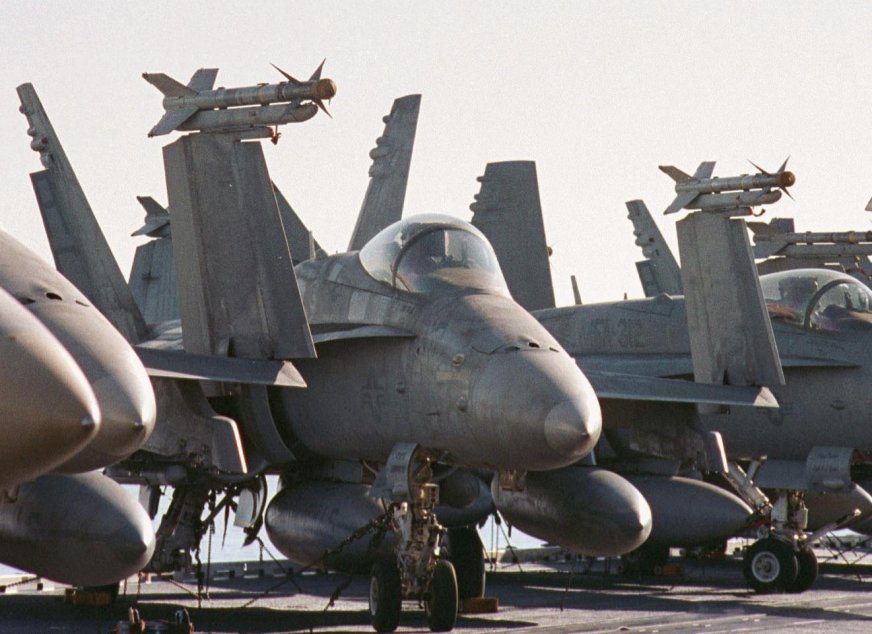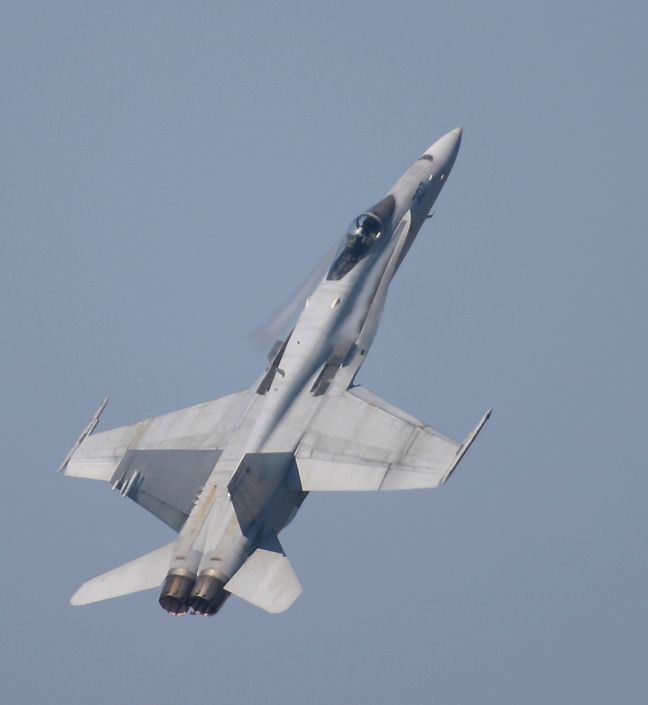|
The F/A-18 Hornet is a single and two-seat, twin-engine, multi-role fighter and attack aircraft. It is carrier-launched,
meaning it can take-off and land on aircraft carriers as well as land bases.
The F/A-18 can escort fighters, suppress enemy defenses, give close and deep air support and also perform day and
night strike, air superiority, forward air control and reconnaissance missions.
The first version of the F/A-18, the F/A-18A/B Hornet became operational with the US Navy and Marine Corps in 1983, replacing
Navy and Marine F-4s and A-7s. To meet the single-place fighter and attack mission capability, full use was made of new technology
in digital computers. Coupled with cathode ray tubes for cockpit displays and appropriate controls based on thorough pilot
evaluations in simulators, a single airplane and subsystems configuration for both missions was evolved.
The F/A-18A/B made its first flight in November 1978. The single-seat F/A-18A and the two-seat F/A-18B underwent most
of their development at testing at the Naval Air Test Center under the new single-site testing concept.
After entering Navy and Marine service, the F/A-18 quickly became renowned as an excellent fighter and attack aircraft
because of its capability, versatility and availability. The Hornet was reliable and easy to maintain. F/A-18s have flown
three times more hours without faliure than other Navy tactical aircraft, while requiring half the maintenance time.
The F/A-18 has been battle tested and has proven to be a reliable and versatile aircraft in combat. The F/A-18 played
an important role in the 1986 strikes against Libya. Flying from the USS Coral Sea, F/A-18s launched high-speed
anti-radiation missiles (HARMs) against Libyan air defense radars and missile sites, effectively silencing them during the
attacks on Benghazi facilities.
The improved F/A-18C (one-seater) and F/A-18D (two-seater) Hornets began deliveries to the US Navy in September 1987,
after a successful run of more than 400 A and B models.
The F/A-18C/D Hornet carries the Advanced Medium Range Air-to-Air Missile (AMRAAM) and the infrared imaging Maverick
air-to-ground missile. In 1989, the C/D models came with improved night attack capabilities. The new components included a
navigation forward looking infrared (NAVFLIR) pod, a raster head-up display, night vision goggles, special cockpit lighting
compatible with the night vision devices, a digital color moving map and an independent multipurpose color display.
F/A-18Cs have synthetic aperture ground mapping radar with a doppler beam sharpening mode to generate ground maps. This
ground mapping capability that permits crews to locate and attack targets in adverse weather and poor visibility or to precisely
update the aircraft's location relative to targets during the approach, a capability that improves bombing accuracy. New production
F/A-18Cs received the APG-73 radar upgrade radars starting in 1994, providing more precise and clear radar displays.

The F/A-18C Night Attack Hornet has a pod-mounted Hughes AN/AAR-50 thermal imaging navigation set, a Loral AN/AAS-38 Nite
Hawk FLIR targeting pod, and GEC Cat's Eyes pilot's night vision goggles. Some 48 F/A-18D two-seat Hornets are configured
as the F/A-18D (RC) reconnaissance version, with the M61A1 cannon replaced by a pallet-mounted electro-optical suite comprising
a blister-mounted IR linescan and two roll-stabilized sensor units, with all of these units recording onto video tape.
On the first day of Operation Desert Storm, two F/A-18s, each carrying four 2,000 lb. bombs, shot down two Iraqi MiGs and
then proceeded to deliver their bombs on the target. Throughout the Gulf War, squadrons of U.S. Navy, Marine and Canadian
F/A-18s operated around the clock, setting records daily in reliability, survivability and ton-miles of ordnance delivered.

Throughout its service, annual upgrades to F/A-18 weapon systems, sensors, etc. continued. The latest lot of the F/A-18C/D
has grown to be far more capable (night attack, precision strike, low observable technologies, etc.) than the original F/A-18A/B;
however, by 1991, it was becoming clear that avionics cooling, electrical, and space constraints would begin to limit future
growth. Additionally, another operational deficiency was beginning to develop. As the F/A-18C/D empty weight increased the
aircraft were returning to the carrier with less than optimal reserve fuel and/or unexpended weapons. The additional range
and "bring back" is not as essential to shore based operations. F/A-18A/B/C/D aircraft will fly for years with the US Marine
Corps and eight international customers: Australia, Canada, Finland, Kuwait, Malaysia, Spain, Switzerland and Thailand. Although
the F/A-18C/D's future growth is now limited, it will also continue to fill a critical role in the US Navy's carrier battle
group for many years to come and will be an excellent complement to the larger, longer range, more capable F/A-18E/F Super
Hornet.

The multi-mission F/A-18E/F Super Hornet strike fighter is an upgrade of the combat-proven night strike F/A-18C/D. The
Super Hornet will provide the US Navy with a platform that has range, endurance, and ordnance carriage capabilities
comparable to the A-6 which has been retired. The F/A-18E/F aircraft are 4.2 feet longer than earlier Hornets, have a 25%
larger wing area, and carry 33% more internal fuel which will effectively increase mission range by 41% and endurance by 50%.
The Super Hornet also incorporates two additional weapon stations. This allows for increased payload flexibility by mixing
and matching air-to-air and/or air-to-ground ordnance. The aircraft can also carry the complete complement of "smart" weapons,
including the newest joint weapons such as JDAM and JSOW. The F/A-18E/F is set to replace the F-14 Tomcat, which was recently
retired from US Navy service.
The Super Hornet can carry approximately 17,750 pounds (8,032 kilograms) of external load on eleven stations. It has an
all-weather air-to-air radar and a control system for accurate delivery of conventional or guided weapons. There are two wing
tip stations, four inboard wing stations for fuel tanks or air-to-ground weapons, two nacelle fuselage stations for Sparrows
or sensor pods, and one centerline station for fuel or air-to-ground weapons. An internal 20mm M61A1 Vulcan cannon is mounted
in the nose.
Carrier recovery payload is increased to 9,000 pounds, and its engine thrust from 36,000 pounds to 44,000 pounds utilizing
two General Electric F414 turbo-fan engines. Although the more recent F/A-18C/D aircraft have incorporated a modicum of low
observables technology, the F/A-18E/F was designed from the outset to optimize this and other survivability enhancements.
The Hughes Advanced Targeting Forward-Looking Infra-Red (ATFLIR), the baseline infrared system for the F/A-18 E/F, will
also be deployed on earlier model F/A-18s. The Hughes pod features both navigation and infrared targeting systems, incorporating
third generation mid-wave infrared (MWIR) staring focal plane technology.

|
|
Specifications (F/A-18C/D Hornet)
Contractor: Boeing (McDonnell Douglas Aerospace) and Northrop Grumman
Powerplant: Two F404-GE-402 afterburning engines, each in the 18,000-pound thrust class
Maximum speed: Mach 1.7
Length: 17.07 metres
Height: 4.66 metres
Wingspan: 11.43 metres
Armament: Internally-mounted M61 Vulcan six-barrel rotary cannon with 500 rounds of 20mm ammunition, two
wingtip stations for AIM-9 Sidewinder air-to-air missiles, two outboard wing stations for air-to-air or air-to-ground weapons,
two inboard wing stations for fuel tanks, air-to-air or air-to-ground weapons, two nacelle fuselage stations for AIM-120 AMRAAMs,
AIM-7 Sparrows or sensor pods, and one centerline station for fuel or air-to-ground weapons
Crew: F/A-18C - one, F/A-18D - two
Cost: $39.5 million (1998 dollars)
Specifications (F/A-18E/F Super Hornet)
Contractor: Boeing (McDonnell Douglas Aerospace) and Northrop Grumman
Powerplant: Two F414-GE-400 engines, each in the 22,000 pound thrust class
Maximum speed: Mach 1.6
Length: 18.31 metres
Height: 4.88 metres
Wingspan: 13.62 metres
Armament: Internally-mounted M61 Vulcan six-barrel rotary cannon with 500 rounds of 20mm ammunition, two
wingtip stations for AIM-9 Sidewinder air-to-air missiles, two outboard wing stations for air-to-air or air-to-ground weapons,
two inboard wing stations for fuel tanks, air-to-air or air-to-ground weapons, two nacelle fuselage stations for AIM-120 AMRAAMs,
AIM-7 Sparrows or sensor pods, and one centerline station for fuel or air-to-ground weapons, two additional wing store stations
Crew: F/A-18E - one, F/A-18F - two
Cost: $60 million (1998 dollars)
|
 |
|
|
 |
|
|
 |
|
|
|

